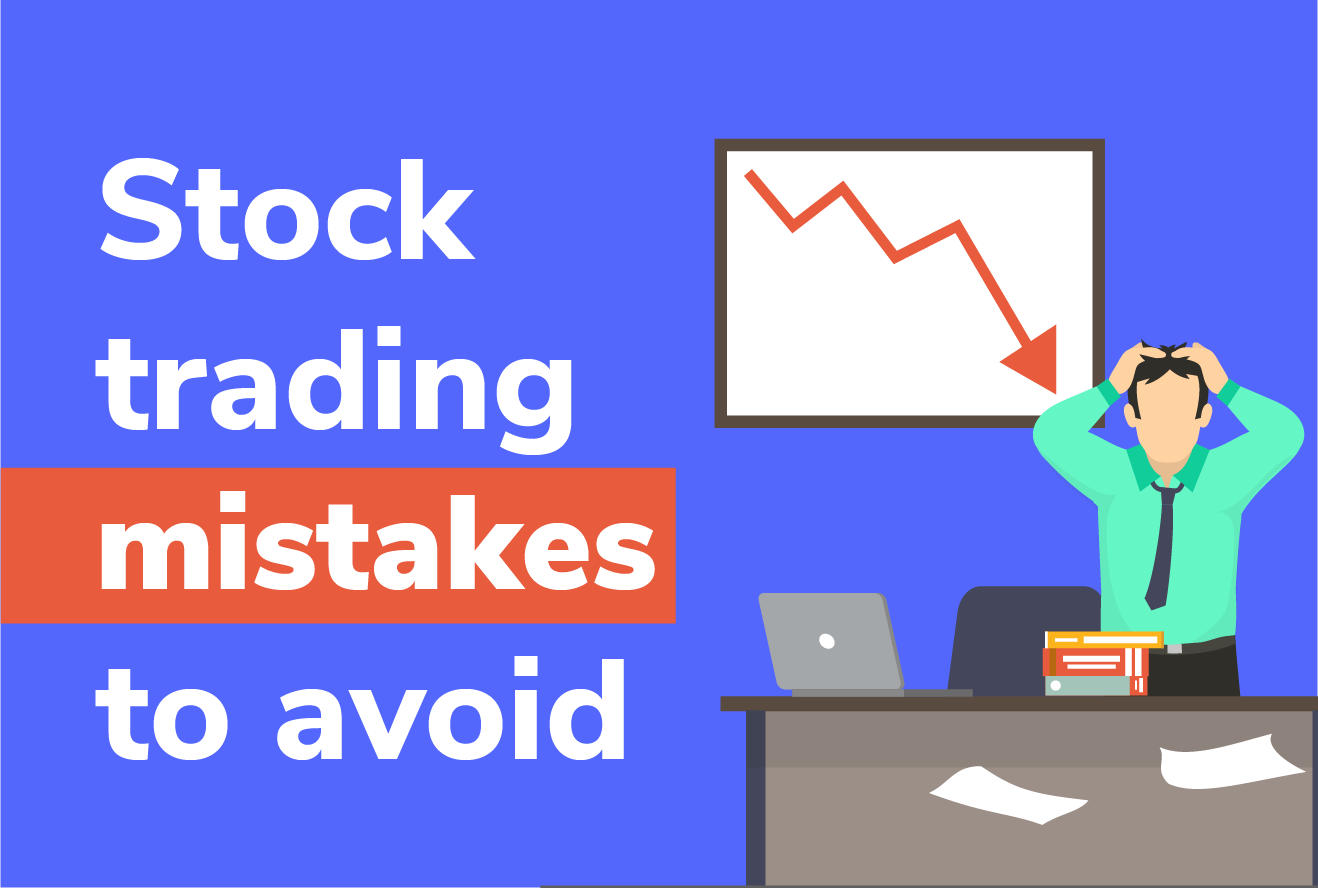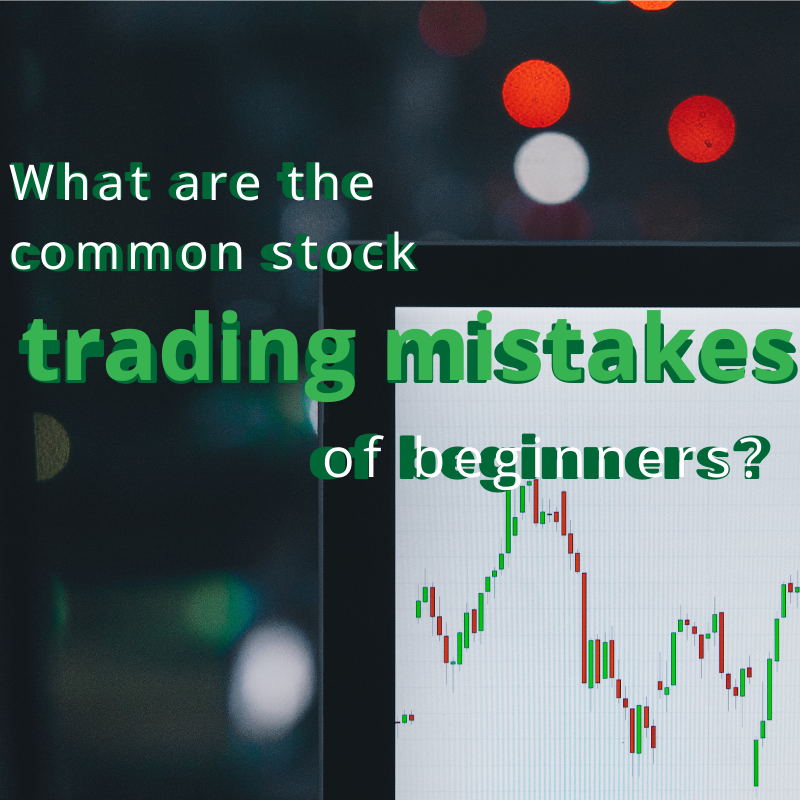No products in the cart.
Financial, Stock Market
Common Stock Trading Mistakes Beginners Must Avoid in 2023
Common Stock Trading Mistakes

Here are the common stock trading mistakes of beginners:
No Trading Strategy
– One of the biggest pitfalls for beginner traders entering the stock market is the lack of a well-defined trading strategy. Without a clear plan, novice traders are often more susceptible to making mistakes that can harm their portfolios. A trading strategy is crucial for managing risks, identifying opportunities, and achieving consistent returns in the long run. Even if beginners have a basic understanding of stock trading, they may find themselves veering off course when faced with market fluctuations or emotional decision-making. This lack of discipline can lead to poor choices that hinder their overall success in the stock market.
Chasing Markets With Strong Performance
– Another common mistake among beginner traders is chasing markets or stocks that have shown strong performance in recent times. Often driven by a “Fear of Missing Out” (FOMO), novice traders tend to gravitate toward assets or stock markets that have historically performed well over the previous few years. This mindset can cloud their judgment and lead to impulsive decisions based on past performance rather than sound analysis.
While it is tempting to invest in markets or stocks that have had a good run, this strategy is risky because past performance does not guarantee future results. The stock market is dynamic, and what goes up can also come down, especially if the market has been performing exceptionally well for an extended period. In many cases, the influx of new traders—also known as “dumb money”—into a market that has been performing well can lead to inflated stock prices, creating a bubble. As experienced traders and institutional investors start to pull out, the market may experience a sharp correction or even a downturn, leaving latecomers at a disadvantage.
For example, consider a scenario where a particular stock has consistently risen in value over the past few years. Beginner traders, observing this performance, might decide to enter the stock at its peak, hoping the trend will continue. However, if the stock is overvalued or the market conditions change, those traders could experience significant losses as the stock price begins to decline. This is where having a solid trading strategy comes into play—rather than chasing high-performing stocks impulsively, traders should evaluate the fundamentals, technical indicators, and overall market conditions before making any investment decisions.
Additionally, beginner traders might rely too heavily on recent performance without considering the long-term potential or underlying risks of a stock. Just because a stock has performed well recently does not mean it will continue to do so indefinitely. Successful traders recognize that short-term market fluctuations are normal, and they focus on making informed decisions based on comprehensive research and analysis.
Failure to Regain Balance
– One of the most common pitfalls for investors, especially beginners, is the failure to properly rebalance their investment portfolio. Rebalancing refers to the process of adjusting your portfolio to return it to the target asset allocation that aligns with your investment strategy. This is important because over time, the performance of various assets in your portfolio can fluctuate, leading to an imbalance. For example, one asset class, such as stocks, may outperform, while another, such as bonds, may underperform. As a result, the original proportions of your investment mix are distorted.
Rebalancing can be difficult because it often requires selling some of your best-performing assets to reinvest in weaker-performing ones. This might feel counterintuitive since it involves selling investments that have provided good returns and increasing exposure to assets that are currently underperforming. However, it is essential to stick to the strategy and rebalance regularly. The goal is to ensure that your portfolio remains aligned with your financial goals, risk tolerance, and time horizon.
For example, imagine you initially decided to allocate 60% of your portfolio to stocks and 40% to bonds. If the stock market performs well over the next few years, the value of your stocks may rise, pushing the proportion of your portfolio in stocks to 80%. Without rebalancing, your portfolio would become more risk-heavy in stocks than you originally intended, potentially increasing your exposure to market volatility. To regain balance, you would sell some of your stock holdings and purchase more bonds, bringing your allocation back to your target levels.
By rebalancing regularly, you ensure that your portfolio remains diversified and aligned with your risk tolerance, helping to manage potential risks while positioning yourself for long-term growth.
Overlooking Risk Aversion
– Another mistake investors often make is overlooking their risk tolerance. Risk tolerance refers to the amount of risk an investor is willing to accept in pursuit of their financial goals. Understanding and respecting your own risk tolerance is crucial because it helps you choose investments that align with your comfort level and financial situation. Some investors may find it challenging to handle the volatility or unpredictability of the stock market, which can lead to emotional decision-making, such as panic-selling during market downturns or avoiding potentially profitable investments due to fear.
Risk tolerance varies from person to person and can be influenced by factors such as age, income, financial goals, and personal temperament. For instance, younger investors with a longer time horizon may be more willing to take on risk, as they have time to recover from potential losses. In contrast, older investors nearing retirement may prioritize stability and preservation of capital, opting for less volatile assets like bonds or dividend-paying stocks.
Before making investment decisions, it’s important to assess your risk tolerance and choose investments that fit your comfort level. If an investment promises high returns but comes with significant risk, it’s essential to weigh the potential benefits against the possible risks, including the potential loss of capital. Diversifying your investments across different asset classes can help manage risk and reduce exposure to any single investment.
Losing Track of Your Time Horizon
– One of the most significant reasons for investment failure is losing track of your time horizon. The time horizon refers to the period over which you plan to invest before needing to access your funds. Understanding your time horizon is essential because different investments perform better over different time frames. For instance, stocks are typically more volatile in the short term but tend to deliver higher returns over the long term. On the other hand, safer investments like bonds may offer more stability in the short term but may not provide as high a return over the long run.
If you do not consider your time horizon when making investment decisions, you risk choosing the wrong assets for your needs. For example, if you are planning to retire in the next five years, investing in high-risk, high-return assets like stocks might not be the best choice, as market fluctuations could jeopardize your retirement funds. Alternatively, if you are young and saving for retirement, investing in growth-oriented assets such as stocks could help maximize returns over time.
Having a clear time horizon allows you to make informed decisions about the level of risk you are willing to take and choose investments that align with your financial goals. It’s also important to regularly revisit your time horizon as your life circumstances change, as this will help you adjust your portfolio accordingly to stay on track to meet your objectives.
Stop-Loss Orders Not Being Used
– Trading without a stop-loss order is like operating a vehicle without brakes—it’s risky, reckless, and often leads to devastating consequences. Despite the importance of stop-loss orders in protecting investments, many traders, especially beginners, continue to trade without utilizing this essential tool. A stop-loss order allows investors to automatically sell a stock when it hits a specific price level, helping to limit potential losses and protect capital.
Without a stop-loss in place, traders are exposed to significant risks, particularly during volatile market conditions where prices can fluctuate dramatically in a short period. The absence of this risk management tool often leads to preventable losses, as traders may hold onto a losing position, hoping the market will turn in their favor. Unfortunately, the longer a position remains unprotected, the higher the risk of larger, more devastating losses.
Experienced traders understand the value of stop-loss orders and use them as part of their overall risk management strategy. These orders provide a clear exit point in case a trade goes against them, allowing traders to minimize losses and preserve their trading capital. It’s important to set stop-loss levels based on individual risk tolerance and market conditions, as different assets and strategies may require different approaches to stop-loss placement.
Letting Losses Increase
– One of the most common mistakes made by beginner traders is letting losses increase by holding onto losing positions for too long. When a trade goes against them, some traders become emotionally attached to their positions, hoping that the market will eventually turn in their favor. This psychological trap can lead to paralysis, where traders become reluctant to cut their losses and move on, even as the market continues to move further away from their original entry point.
Allowing losses to increase in this way can have serious consequences, as it ties up capital in unproductive positions. Instead of cutting their losses and reallocating their capital to more promising opportunities, traders may let their losses grow, leading to even larger losses over time. The longer a losing trade is held, the more capital is tied up, and the more difficult it becomes to recover from those losses.
In addition to depleting capital, holding onto losing trades for too long can also result in missed opportunities. The capital tied up in a losing position could have been better used elsewhere, whether in another asset or in a different trading strategy. Traders should be proactive about cutting their losses and re-evaluating their positions to ensure they are making decisions based on logic, rather than emotional attachment.
To avoid this pitfall, traders should have a clear exit strategy in place before entering a trade, which includes setting stop-loss orders and sticking to predetermined loss limits. This disciplined approach helps prevent traders from holding onto losing positions out of hope or fear, ultimately leading to more rational and profitable decision-making.
Taking Too Big Positions
– Without a question, every trader dreams of winning a large deal. There is no assurance that the trade will go as desired by the investor. Therefore, if an investor puts 50% of his money at risk in one transaction and that deal fails, it will significantly reduce his trading capital.
The Value of Acknowledging Losses in Common Stock
– Investors much too frequently refuse to acknowledge the truth that they are only human and subject to error, just like the best investors. Holding onto a lost investment out of pride rather than financial necessity is the worst thing an investor can do.
Believing in False Buy Signals
– A decrease in common stock price could be caused by deteriorating fundamentals, the resignation of a CEO, or greater competition. The same factors also indicate that the common stock may not rise for a while. Beginner investors frequently trust this without doing any research.
Purchasing With Excessive Margin
– The worst thing a novice trader can do becomes overexcited with what appears to be free money. If he uses margin and his investment doesn’t work out as he had hoped, he will be left with a significant debt obligation.
Over Leveraging
– Beginner traders may be mesmerized by the amount of leverage they have, mainly when trading forex, but they may quickly learn that too much leverage can quickly wipe their trading capital. A 2% negative swing is all it takes to wipe out one’s capital when a leverage ratio of 50:1 is used in retail forex trading.
Following the Crowd
– Another common error beginner traders make is blindly following the crowd. As a result, they may overpay for hot common stocks or start short positions in assets that have previously fallen and may be about to recover.
Not Diversifying
– Many inexperienced common stock traders need to diversify their holdings. The fact that diversification lowers risk is what makes it so crucial. If an investor invests in various stocks, he reduces the likelihood that one of them will fail and lose everything.
Neglecting Assignments
– Before starting a transaction, new traders frequently need to do their homework, research, or exercise due diligence. For a novice trader, the need to execute a deal quickly sometimes outweighs the need to conduct some research, but this could lead to an expensive lesson later on.
Buying False Tips in Common Stock
– Most investors fall victim to this error sometime during their investment careers. Even if these recommendations are accurate, that does not necessarily mean that an investor needs to open his online brokerage account immediately and place a buy order on the common stock because it is “the next big thing.”
Excessive Financial Television Viewing
– Almost no information about achieving your goals can be found on financial news programs. Would they tell it on TV or sell it to you for money if they genuinely had great common stock tips, trading guidance, or a secret formula to earn big money? No. They would remain silent, amass their fortune, and wouldn’t require the sale of a newsletter to survive.
Unable to See the Big Picture
– A qualitative analysis or considering the big picture is one of the most crucial yet frequently skipped steps for a long-term investor. Therefore, pouring through financial accounts or trying to spot buy and sell chances may often be successful still, if the world is shifting against the company.
Trading Several Markets in Common Stock
– Beginner traders may switch between markets, such as stocks, options, currencies, commodity futures, etc. Trading in several markets can be quite distracting and may impede a new trader from getting the experience required to succeed in one market.
The Risk of Over-Confidence
– Although trading is a reasonably tough profession, some new traders may mistakenly feel that it is the proverbial shortcut to easy money due to their “beginner’s luck” experience. Such overconfidence is risky since it promotes complacency and excessive risk-taking, which could lead to a trading disaster.
Inexperienced With Day Trading
– Only the most experienced investors should attempt day trading because it can be risky. Think twice before day trading unless a trader has the necessary knowledge, a platform, and access to quick order execution. There are much better options for traders who want to accumulate wealth if they aren’t very good at managing risk and stress.
Underestimating Capabilities
– Some investors tend to think that because sophisticated investors are the only ones who can succeed in the stock market, they will never be successful investors. Refrain from assuming that a trader’s day job prevents him from successfully trading in the financial markets. Keep in mind that a lot of investing involves using logic and common sense.
Getting Emotional
– All traders have felt that way when they’re having a good run and believe they can do no wrong. It’s good to be enthusiastic about trading; confidence is always a plus, but avoid letting your emotions control your trading decisions and forcing yourself into positions you wouldn’t normally take.
Investing Before Being Financially Ready
– Stock market trading is risky for novice investors because results aren’t always guaranteed. For instance, they could experience losses during bad markets and wind up with even greater debt.
Not Tracking Trades in a Trading Journal
– A successful trader requires him to keep a trading journal, which is essential. It takes a little more knowledge and focuses than simply writing down your entry and exit points for winning trades.

READ MORE RELATED BLOGS!
READ MORE AND SHARE!
TSOK Chronicles: Unleashing Passion, Dedication, and Excellence in 2024
2023 Your Practical Wedding Guide
Investments and Finance Ultimate Guide
If you like this article please share and love my page DIARYNIGRACIA PAGE Questions, suggestions send me at diarynigracia@gmail.com
You may also follow my Instagram account featuring microliterature #microlit. For more of my artworks, visit DIARYNIGRACIA INSTAGRAM


Peace and love to you.